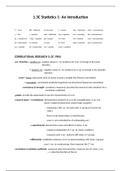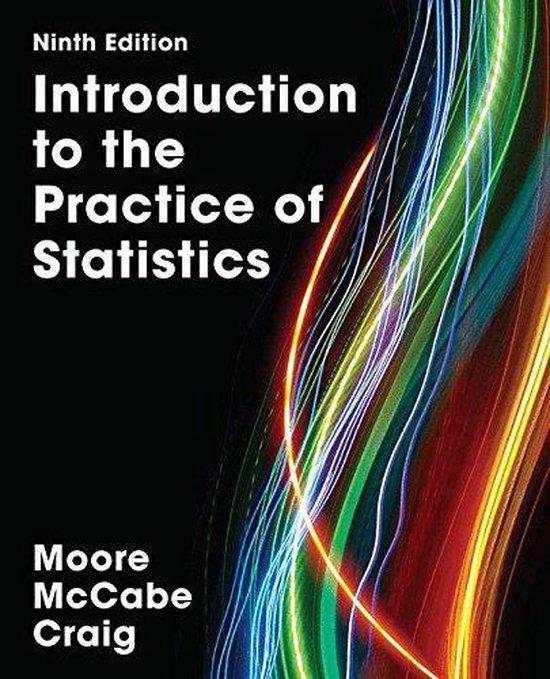1.3C Statistics 1- An introduction
↑ = more diff. = different bc =because f. = factors beh. = behaviour envir. = environment
↓ = less + = positive indiv. =individual org.= organism acc.= according dev.= development
sit. = situation/al -/neg. = negative ppl = people w/= with wo/= without char.= characteristics
inf.= information m= months y= years lvl= level betw.= between perf.= performance
var.= variable rel.= relationship var.= variable cond.= condition
CORRELATIONAL RESEARCH (1.2C- PB4)
-rel.: direction→ positive rel.- positive values (x > 0), tendency for 2 var. to change in the same
direction
→ negative rel.- negative values (x ‹ 0), tendency for 2 var. to change in the opposite
direction
: form→ linear- data points tend to cluster around a straight line (Pearson correlation)
→ monotonic- consistently positively/negatively one-directional (Spearman correlation)
: consistency & strength- consistency measured, described by numerical value obtained for a
correlation coefficient
-graphs- provide the opportunity to see the characteristics of a rel.
-research types→ correlational- demonstrates existence of a rel. (its strength) betw. 2 var. but
doesn’t explain it/determine causes/imply causation
- measuring 2 diff. var. for each indiv. (1 group w/2 scores for
indiv.)
- there is only observation, no interference
- envir. is not controlled (bc of confounding var.)
→ experimental- demonstrate cause-and-effect rel. betw. 2 var.
- requires manipulation of 1 var. to create conditions
- measures only 1 var., looks for diff. betw. 2/+ groups
→differential- establishes existence of rel. by demonstrating a diff. betw. 2 groups
-uses 1 var. to create groups, then measures the 2 nd var.
-correlation/correlation coefficient- numerical value that describes, measures the rel. betw. 2 var.
- +/- describe direction of the rel.
, - numerical value (0.0-1.0) describes strength, consistency, type
(Pearson/Spearman) indicates the form
-statistical significance- real rel. that exists in population, interprets the strength
-coefficient of determination- squared value of correlation (r2)
-measures % of variability in 1 var. predicted by the other var.
-prediction- using knowledge about 1 var. to help predict/explain the 2 nd var.
- regression- process of using 1 var. to predict another
-multiple regression- 1 var. can be explained by a set of others
- var.: predictor var.
: criterion var. (being explained/predicted)
-non-numerical scores: 1. one score numerical, the other non-numerical
-organize the score into separate groups
2. both non-numerical
-organize data in a matrix w/rows and columns
-reliability- consistency/stability of measurements
-validity- extent to which measures actually measure what they´re supposed to
-limitations→ 3rd var. problem- possibility of 3rd unknown var. controlling var. influencing the rel.
→ directionality- inability to determine which var. is the cause, which the effect
-causality- 1 event affects the other
MEETING 1
Passer CH1: Science and Psychology
-methods by which ppl hold beliefs:
→tenacity- believing something simply bc it is what we have long believed
→authority- relying on other ppl as our source of knowledge and beliefs
-when: we believe the person has expertise of the subject
: we perceive the person as trustworthy
→reason- use of logic/rational arguments to reach a conclusion (used by scientists to
construct theories, derive hypotheses to test theories)
, →empiricism- acquiring knowledge through observation, experience (all knowledge derived
from experience)
-confirmation/congeniality bias- tendency to seek inf. supporting our views,
avoiding disconfirming inf.
→science- systematically gathering and evaluating empirical evidence to answer questions,
test ideas
-relies on empirical evidence, reasoning
-scientists want to describe, explain, predict and control events
-variable- factor/attribute that can assume 2/+ values (can differ, change)
-description- involves dev. of coding systems, identifies things
-explanation→ hypothesis- proposition about the causes/outcomes of an event, how variables are
related (formed by reasoning)
→theory- set of formal statements specifying how/why variables are related
-broader than hypotheses
-causes: distal- remote causes
: proximal- immediate causes
-causal inference- to conclude that var. X had a causal effect on var. Y
: covariation- as X changes, Y changes
: temporal order- change in X occurs before the change in Y
: absence of plausible alternative explanations
-prediction- hypothesis/theory testing, applied prediction (if….then)
-2 var./events related→ using knowledge about 1 var. to make predictions about the other
-control- having an influence over research settings/procedures/application of scientific knowledge
-being able to decide what var. to study, know when to measure them
-applying scientific knowledge to improve lives
-assumptions: events are not random, they are regular/in pattern
: patterns have underlying causes
: causes are possible to discover
-empirical question/claim- can be tested through observation
-falsifiability- an assertion is testable if we can envision gathering some type of empirical evidence
that will reveal the assertion as false
-operationism- defining a concept in terms of the specific procedures used to represent it
-replication- process of repeating a study to determine whether the original findings will be upheld






